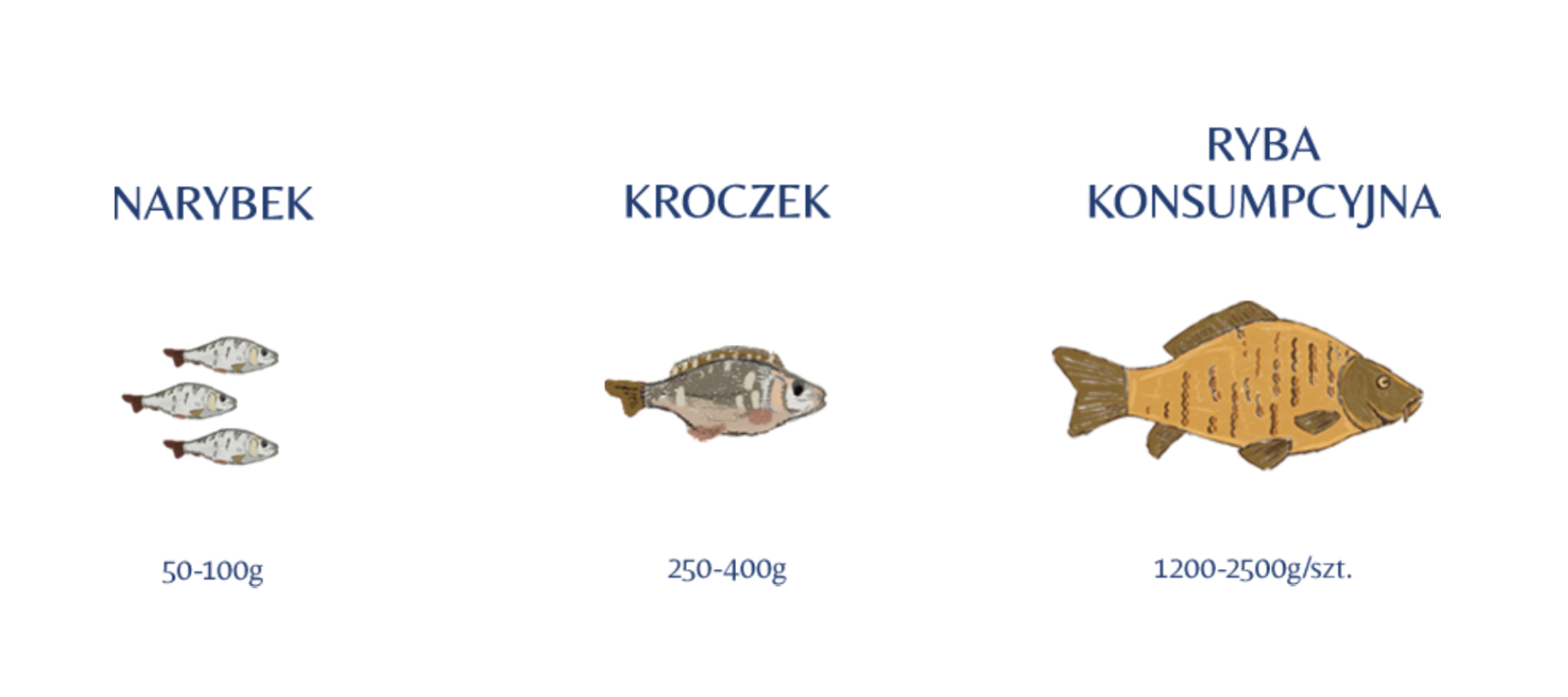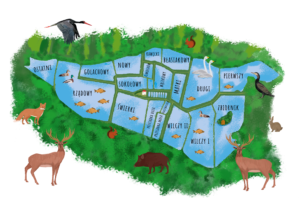Organic carp farming
Carp are doing well here. Our BIO farm offers a lot of space and a natural space where fish can live and grow freely. Twenty ponds create ideal conditions for the development of carps, a natural diet supports their healthy growth, and constant veterinary care ensures that the fish are well cared for.
Where do carp live?
Carp at Zawólczu have as much 20 ponds. The total area of the water table is 143 hectares. So the fish have a place to swim. Each pond has its own name and plays its role in BIO breeding. The largest of our reservoirs is the Government Pond; apart from it, we also have, for example, Świerki, Golachowy and Trzeci ponds. The names of ponds correspond to their purpose, and sometimes result from their location or the environment in which they are located. The bottom of the ponds is sandy and the water is properly oxygenatedand at a temperature that is favorable for carp - we monitor it on an ongoing basis.
OUR PONDS
Do all carp swim together?
No, only carp peers. We use a system invented by Thomas Dubish in the 19th century. This is called replanting, i.e. dividing carps according to age: older carps stick with older ones, and young – with young ones . Additionally, larger fish swim in larger and deeper ponds. The young ones have to grow up – At first they swim in fry ponds .
What do carp eat?
Whenever they get hungry, our carps feed on what they find in the ponds . They can roam around as much as they want and take advantage of what nature has to offer. Young carp feed on plankton; the older ones are looking for more food. Sometimes these are small larvae and insects, and sometimes larger mollusks. Carp are predators and like to hunt at the bottom of our reservoirs. We don't disturb them, it's their basic diet. However, from time to time, carps (especially growing ones) also receive an additional supply of energy from us, so we feed them with cereals, among others. those that come from our organic crops. In winter, carp do not eat anything because they are simply not hungry then.
Carp's health
We constantly monitor whether our carp are doing well and doing well he best conditions for healthy growth. The veterinarian with whom we constantly cooperate takes care of our patients and their well-being.
How long do carp take to grow?
Nim trafią do sprzedaży, nasze karpie dorastają przez 3 lata. Dojrzewają naturalnie, nie przyspieszamy ich wzrostu. Jednak dzięki technice przesadkowania dorastają szybciej o 2-3 lata niż w standardowych warunkach.

CARP GROWING UP
Fry growing up
Just after birth, small carps are called hatching. In spring, 2-3 mm fish are placed in frying ponds, which are previously properly cultivated. After a few weeks, they are big enough to eat what we provide them with, in addition to plankton. At the end of summer they reach a weight of 50-100 g and in October they are caught, selected and released into ponds again. The fry spends the winter in a pond, which will be its home in the following year, or in a collecting pond, zimochow. It's deeper here and the water is well oxygenated thanks to this, the carps welcome another spring in good condition.
When the carp becomes "kroczek".
In spring, carp start a new stage. Those that spent the winter in the target pond continue to live there. We catch the carp that wintered in the hibernaculum, examine it and finally move it to a new home. When it gets warmer, the fish in the pond get hungry, so they look for food. At the end of May they will receive additional food from us again, but before that they feed themselves. Over the following months, carp eat, are trial-caught and examined - and so on until October, when they begin to hibernate again. This season, carp reach a weight of 250-400 g and become teenagers in the fish world, i.e. baby fish.
Carp enters adulthood
The third year is the magic limit for carp – in the following months, they eat more and more, grow and become adults. When they reach a weight of 1200-2400 g, we call them consumer fish. This rapid maturation requires great vigilance from us. We monitor water quality and oxygenation as well as fish health throughout the summer. In October, carp are caught and transported to fish warehouses. These are tanks with perfectly oxygenated, fresh water. They can be called a waiting room - from here it's a straight path to the target customer or to our fish processing plant, where we prepare our BIO products.
Before the carp get to you
After the carps are caught, they go to our newly established processing plant. This is where we prepare products for sale. We are helped by machines that make this process run smoothly. We owe the smaller number of bones in carp to a special cutter. The shape of the bell is obtained with the help of a bell, and the lobes are obtained with the flaps. Additionally, EU support allowed us to adapt the processing plant to appropriate packaging and storage of fish – carps stay fresh thanks refrigeration chamber and modified atmosphere packaging.
Organic certificate
Ekologiczny status karpi z naszej hodowli potwierdza certyfikat przyznany przez Ekogwarancję PTRE. To nie jedyny dokument, który gwarantuje, że nasze produkty są wysokiej jakości. Posiadamy też certyfikat przestrzegania Kodeksu Dobrej Praktyki Rybackiej, jedyny w Polsce uznawany przez Ministra Gospodarki Morskiej i Żeglugi Śródlądowej. Dzięki tym dokumentom możemy śmiało przyznać, że nasze karpie są BIO.




